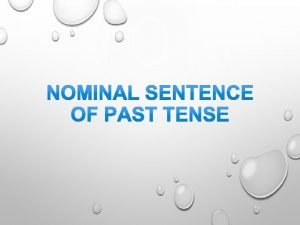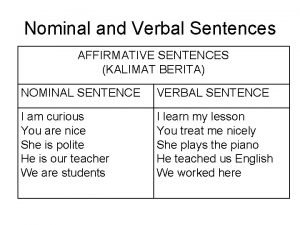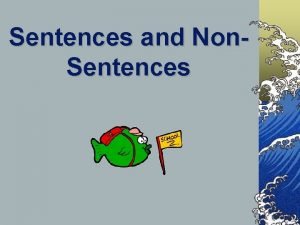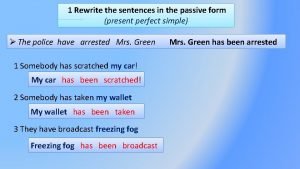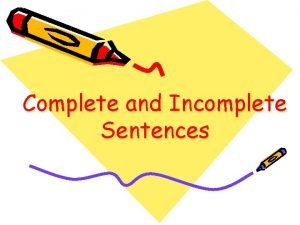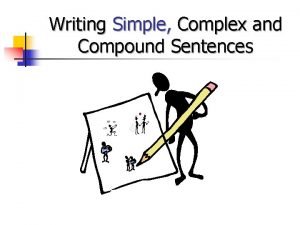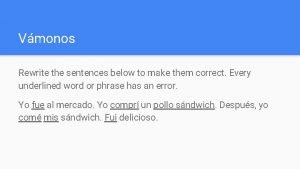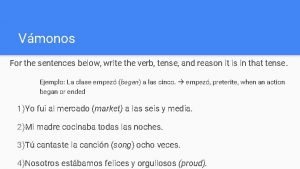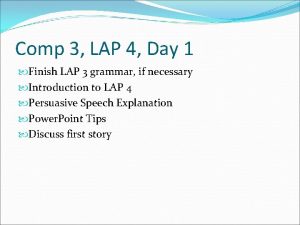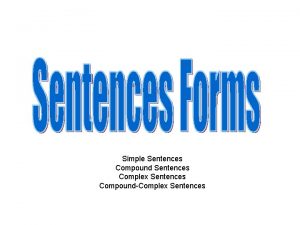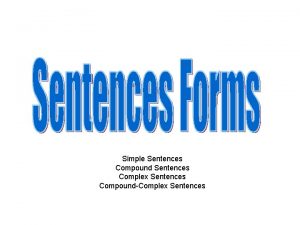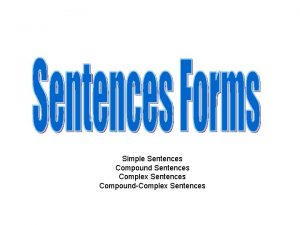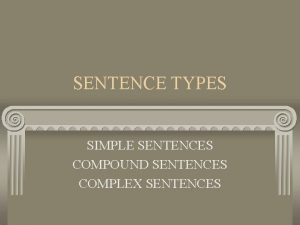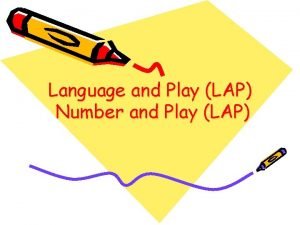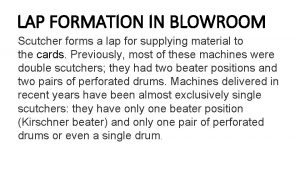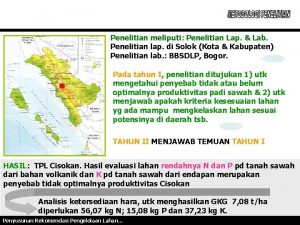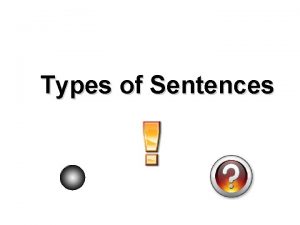TYPES OF SENTENCES Mrs Hackworth Comp 1 LAP













- Slides: 13

TYPES OF SENTENCES Mrs. Hackworth Comp 1 LAP 3

Achieving Sentence Variety ◦ Once a writer knows the difference between the sentence types (simple, compound, complex and compound- complex), it is possible to write with sentence variety. ◦ Sentence variety helps make your writing more interesting.

Independent Clause ◦ What Is an Independent Clause? (with Examples) ◦ An independent clause is a clause that can stand alone as a sentence (i. e. , it expresses a complete thought). An independent clause, like all clauses, has a subject and verb. When there are no dependent clauses in the same sentence as an independent clause, the independent clause is a simple sentence. For example: I like coconut macaroons. ◦ (This is an independent clause and simple sentence. )I like coconut macaroons even though I dislike coconut. ◦ (This is an independent clause and a dependent clause. This is a complex sentence. )

Dependent Clause ◦ What Is a Dependent Clause? (with Examples) ◦ A dependent clause (or subordinate clause) is one that cannot stand alone as a complete sentence because it does not express a complete thought. Like all clauses, a dependent clause has a subject and verb. Examples of Dependent Clauses ◦ Here are some examples of dependent clauses (shaded). Notice how the shaded clauses could not stand alone as sentences. This is how a dependent clause differs from an independent clause. The crew could see the whale, which had surfaced only 50 m behind them. ◦ Do you know the butcher who went to court on Saturday? ◦ I am not tidying the dishes unless Peter helps. ◦ The excellence of a gift lies in how appropriate it is rather than how valuable it is.

Sentence Types by Shmoop: HTTPS: //WWW. YOUTUBE. COM/WATCH? V=98 OCAE 5 O 0 WS

Simple Sentence ◦ A simple sentence contains a subject and verb. ◦ It expresses a single complete thought. ◦ A simple sentence is a single independent clause.

Compound Sentence ◦ A compound sentence contains two independent clauses. ◦ Conjunctions (for, and, nor, but, or, yet, so) join these independent clauses. (Hint: The conjunctions spell FANBOYS. ) ◦ The conjunction used can impact the meaning of the sentence.

Complex Sentence ◦ A complex sentence is an independent clause joined by one or more dependent clauses. ◦ A subordinating conjunction begins the dependent clauses. ◦ A dependent clause that begins a sentence must be followed by comma. ◦ A dependent clause has a subject and a verb, but it does not make sense on its own.


Compound-Complex Sentence ◦ A compound-complex sentence has one complex sentence joined to a simple sentence with a conjunction making it compound-complex.

Sentence Tips ◦ Remember that a compound-complex sentence contains at least 2 complete sentences joined by a conjunction. ◦ Remember that a compound-complex sentence also contains a dependent clause (or introductory clause).

LET’S PRACTICE!

Homework due next class In your notebook or loose-leaf: 1. Write 3 simple sentences, 2. Write 3 compound sentences, 3. Write 3 complex sentences, 4. Write 3 compound-complex sentences. Be sure to identify the type of sentence (i. e. : . Simple Sentence: The dog wagged his tail. ) 5. Highlight any and all independent clauses pink. 6. Highlight any and all dependent clauses yellow.
 Endlap and sidelap
Endlap and sidelap They are mrs garcia and mrs castro
They are mrs garcia and mrs castro They are mrs garcia and mrs castro
They are mrs garcia and mrs castro Mrs. darling was ___________ of mrs. s.
Mrs. darling was ___________ of mrs. s. Write three positive sentences of nominal sentences
Write three positive sentences of nominal sentences Nominal verbal sentence
Nominal verbal sentence Non sentences
Non sentences Rewrite sentences in the passive voice
Rewrite sentences in the passive voice Complete the incomplete sentence
Complete the incomplete sentence Compound sentence
Compound sentence Rewrite the following sentences to form one sentence
Rewrite the following sentences to form one sentence Verb below
Verb below Slot weld definition
Slot weld definition Lap weld
Lap weld




